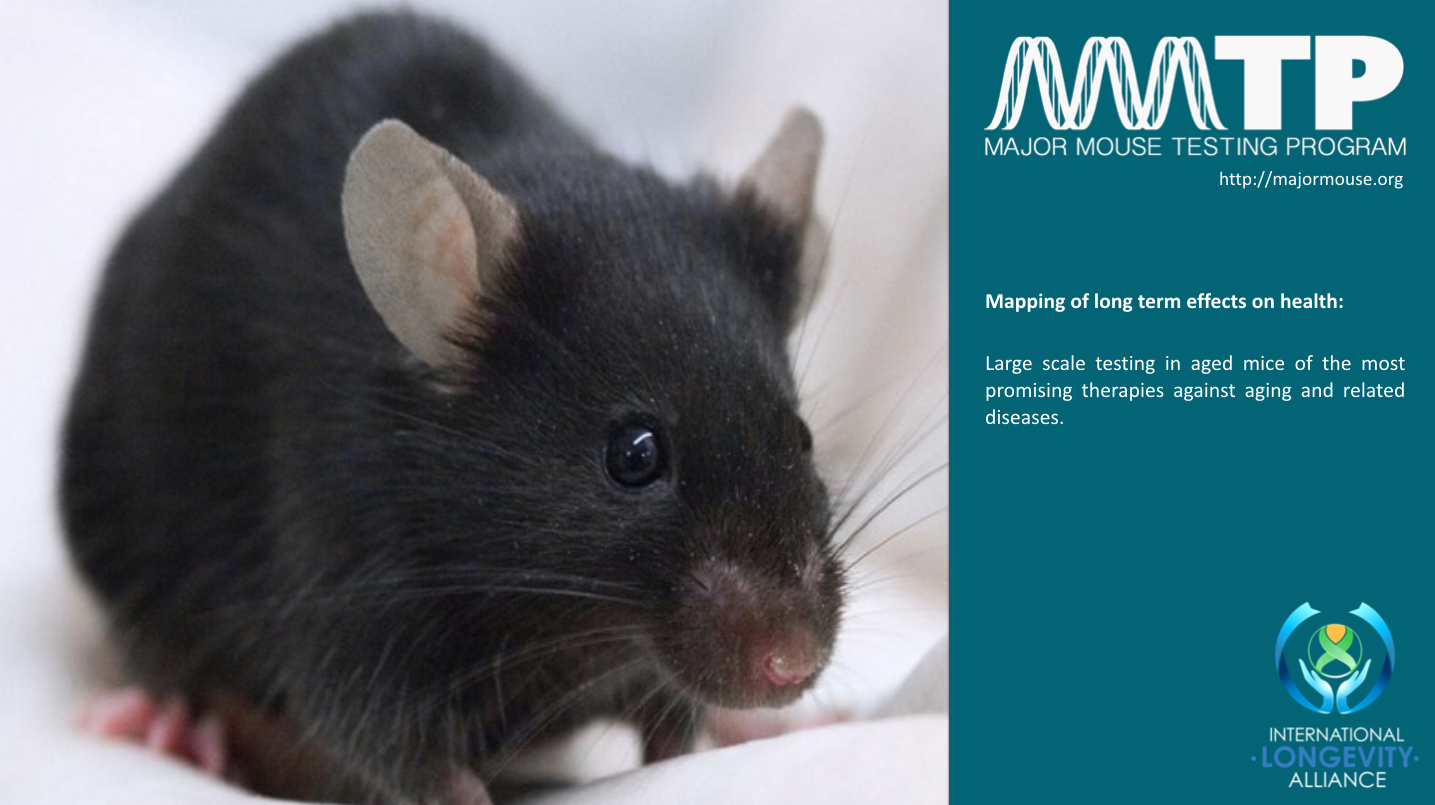Major Mouse Testing Program Aims To Fast Track Regenerative Medicine
Steve Hill / Op Ed
Posted on: January 8, 2016 / Last Modified: January 8, 2016
 The field of regenerative medicine is becoming increasingly important for the future of healthcare and even how we view aging. With stem cell technology, gene therapy and other longevity technology on the horizon humanity can finally consider living longer, healthier lives.
The field of regenerative medicine is becoming increasingly important for the future of healthcare and even how we view aging. With stem cell technology, gene therapy and other longevity technology on the horizon humanity can finally consider living longer, healthier lives.
The goal of regenerative medicine is both quantity and quality whilst traditional medicine has provided quantity often at the cost of quality. Regenerative medicine proposes to reduce the frailty and decline of old age by rejuvenating the body and promoting healthy longevity. With advances in technology, research and our understanding of the aging process, this is now becoming a realistic proposition.
Some drugs already tested have been found to increase mouse lifespan such as Metformin 1,2 and Rapamycin 3.These drugs are even now moving into human clinical trials to see if the above benefits translate into people. However, there are many more promising substances that have never been properly tested and we do not know if they could extend healthy lifespan.
How fast science advances depends on how much quality research is being conducted. Currently there are few high impact studies investigating lifespan initiated each year and with so many promising substances to test this is all a painfully slow process. The Major Mouse Testing Project [MMTP] is aiming to help by rapidly testing compounds and speeding up progress.
The problem with lifespan studies
A significant problem with longevity research and testing in the past has been a lack of robust results. Small animal cohorts and questionable husbandry, combined with poor metrics or protocols, have lead to inconsistent or even conflicting results4. In a field as poorly funded as longevity research currently is, we cannot afford to waste money and effort on flawed experiments, that do not provide solid evidence of efficacy and high potential for human clinical trials.
The Major mouse testing program is working to redress this situation with the help of an international team of dedicated researchers. We hope to deliver the kind of consistent and quality data required to provide definite confirmation of longevity interventions. We plan to initiate large scale testing on already aged mice – the approximate equivalent of a human aged sixty. This means we can produce consistent, accurate and notably faster results to drive progress.
It is also plausible that some interventions, when combined, could have a synergy where the effects are greater than the individual compounds, such as the case with Dasatinib & Quercetin. It is possible there are more synergies to be discovered and this is where the MMTP plans to push forward, not only testing single interventions but also in testing combinations to seek out these powerful synergies. Our researchers are working on a practical solution to test these combinations and at the same time hope to provide the kind of accurate data science demands to prove efficacy.
We have opted to test with mice partly due to the costs involved – their maximum lifespan is relatively short so they provide faster results. Mouse studies are also considerably easier to organize and are the usual starting point prior to moving into higher animals and, ultimately, to humans. Organisations such as the FDA for example, also usually require substantial animal data prior to approving any clinical trials involving people, so this is another reason for choosing to begin here.
We plan to repeat any positive results we achieve using rats as confirmation of our work and to demonstrate translation of an intervention. The lab rat is an excellent way to confirm results and, in drug development, is routinely employed to demonstrate therapeutic efficacy and assess toxicity of drug compounds prior to human clinical trials.
The first steps
Our project ultimately aims to combine three international labs and research teams, working together to initiate large scale lifespan intervention testing. In the early part of 2016 our first lab in Germany, under the guidance of Dr Alexandra Stolzing, will begin testing.
Dr Alexandra Stolzing is our lead researcher and manages a team based in the Leipzig university laboratory in Germany. The lab is equipped with excellent rodent study facilities, providing a high level of animal care, combined with state of the art equipment ideal for the demands of animal health and lifespan studies.
Dr Stolzing has extensive experience in stem cell transplantation and regenerative medicine with numerous high impact papers with high profile scientific publishers.
The initial phase of the project has a limited number of substances to be tested, but it will also demonstrate that our team is able to conduct the kind of large scale quality lifespan studies that our field of work desperately needs. The MMTP plans to test the following compounds and apply them to lifespan studies.
Senolytics : A new class of drugs
Senolytics are a relatively new class of drugs that focuses on the removal of senescent cells. The presence of senescent cells are thought to contribute to aging decline, and thus their removal is a potential strategy for promoting health and longevity.
Cells become senescent as a result of damage, toxins, and stress, ceasing to divide and they are generally destroyed, either by their own programmed cell death mechanisms or by the immune system.
However, as the body ages, some of these cells evade such a fate and remain in the body. While senescent cells comprise only a small number of total cells in the body they secrete proinflammatory cytokines, chemokines, and extracellular matrix proteases, which together form the senescenceassociated secretory phenotype or SASP. This toxic mixture of secreted signals then starts damaging the surrounding tissues, generating inflammation, remodeling important structures, and eventually encouraging the generation of cancer rather than suppressing it.
The health and lifespan of mice have been demonstrated to improve by the clearance of senescent cells using a transgenic suicide gene5 and later experiments show that the same could be achieved using a small molecule approach6.
Increased expression of prosurvival networks in senescent cells, was discovered through transcript analysis, consistent with their resistance to apoptosis. Drugs targeting these same prosurvival factors selectively killed senescent cells. Two such drugs were Dasatinib and quercetin, which were both able to remove senescent cells but were better in differing tissue types. However it was discovered that a combination of the two drugs formed a synergy that was significantly more effective at removing senescent cells6.
These results suggest the feasibility of selectively ablating senescent cells and the efficacy of senolytics for alleviating the symptoms of aging decline7,8.
More recently additional Senolytic compounds have been identified, again with promising results9,10. Another recent approach rather than removing the SASP was to target the JAK signalling pathway to suppress the negative signalling instead11. Whilst results are interesting this is not as effective as removing the problem cells fully, it does however demonstrate once again the benefits of removing the harmful signalling senescent cells produce.
We will test Dasatinib and quercetin and also aim to test Navitoclax and apply them both to quality lifespan studies. The evidence to support senolytics is mounting rapidly and we are keen to explore their potential for healthy longevity.
Rapamycin
This compound is known to increase mouse lifespan so we will be using it in all of our labs. This will serve as our positive control group, ensuring all of our labs are operating to the same high standard and are producing the same consistent data. This is an important step towards ensuring the quality of the data and supporting our results should lifespan increases be confirmed.
Leading the charge to speed up progress
The Major Mouse Testing Program is helping speed up the progress of longevity research by creating the kind of quality animal data needed to justify further investment and funding in our important field. We believe our work will be instrumental in speeding up scientific progress and justifying further investment in the field of regenerative medicine.
We will be launching our fundraising campaign in 2016 and we will be working hard to speed up progress in the field of regenerative medicine.
About the Author:
 Steve Hill is a longevity advocate and a project coordinator for the Major Mouse Testing Project. Based in the UK he is a statistical data analyst by day and a longevity research activist by night. An advocate of scientific advancement and regenerative medicine he is actively involved within the International Longevity Alliance of which the MMTP is a project group.
Steve Hill is a longevity advocate and a project coordinator for the Major Mouse Testing Project. Based in the UK he is a statistical data analyst by day and a longevity research activist by night. An advocate of scientific advancement and regenerative medicine he is actively involved within the International Longevity Alliance of which the MMTP is a project group.
References:
1. MartinMontalvo, A. “Metformin improves healthspan and lifespan in mice.” 2013. http://www.ncbi.nlm.nih.gov/pmc/articles/PMC3736576/
2. Anisimov, V. N. et al. Metformin slows down aging and extends life span of female SHR mice http://www.ncbi.nlm.nih.gov/pubmed/18728386
3. Comparison of rapamycin schedules in mice on highfat diet http://www.ncbi.nlm.nih.gov/pmc/articles/PMC4614913/
4. Review of the literature and suggestions for the design of rodent survival studies for the identification of compounds that increase health and life span http://link.springer.com/article/10.1007/s113570119224/fulltext.html
5. Clearance of p16Ink4apositive senescent cells delays ageingassociated disorders http://www.nature.com/nature/journal/v479/n7372/full/nature10600.html
6. The Achilles’ heel of senescent cells: from transcriptome to senolytic drugs http://www.ncbi.nlm.nih.gov/pmc/articles/PMC4531078/
7. Cellular senescence and the senescent secretory phenotype: therapeutic opportunities http://www.ncbi.nlm.nih.gov/pmc/articles/PMC3582125/
8. Clinical strategies and animal models for developing senolytic agents. http://www.ncbi.nlm.nih.gov/pubmed/25446976
9. Identification of a Novel Senolytic Agent, Navitoclax, Targeting the Bcl2 Family of AntiApoptotic Factors http://onlinelibrary.wiley.com/doi/10.1111/acel.12445/abstract
10. Clearance of senescent cells by ABT263 rejuvenates aged hematopoietic stem cells in mice http://www.nature.com/nm/journal/vaop/ncurrent/full/nm.4010.htm
11. JAK inhibition alleviates the cellular senescenceassociated secretory phenotype and frailty in old age http://www.pnas.org/content/112/46/E6301.full








